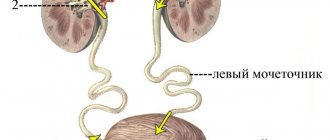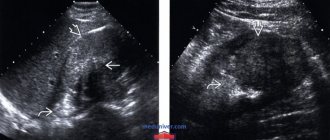Kidney pathologies occur quite often in humans. The most common are urolithiasis and pyelonephritis. However, no less common is such a pathology as an atypical kidney cyst. The formation is localized in the tissues of the kidney and is a round bubble filled with lemon-yellow liquid. An atypical renal cyst is characterized by the presence of septa in it. We will discuss how cystic formations are treated and what the risks are for the patient in the material below.
Important: atypical kidney cysts can affect both men and women equally.
Causes
In urological practice, there is no single factor that would cause the formation of a right-sided renal cyst. Despite this, kidney injuries play a significant role in the development of a benign structure.
Another predisposing factor in the occurrence of this disease is infectious and inflammatory pathologies of the urinary system, in particular pyelonephritis.
The hereditary factor also plays a significant role. If close relatives of the patient were previously diagnosed with a similar pathology, then the risk of a cyst increases several times.
Other predisposing factors for the development of right-sided renal cysts include:
- Urolithiasis disease;
- Pulmonary tuberculosis;
- Previously undergone surgical interventions on the urinary organs and directly on the right kidney;
- Hypertonic disease.
Important! Very often this pathological phenomenon is diagnosed in people over 50 years of age. As a rule, these are people who have a congenital genetic predisposition to the development of kidney disease, as well as having abnormalities in the development of the paired organ.
Classification
Considering the nature of their occurrence, cellular composition and location, cysts on the right kidney are divided into several types, which simplifies their diagnosis and treatment. Depending on the origin and structure, congenital and acquired cysts are distinguished.
The acquired variant of neoplasms has a secondary etiology and is formed against the background of other diseases of the urinary organs.
The congenital type of renal cysts is classified into the following types:
- Dermoid cyst. This type of neoplasm has a connective tissue capsule, but instead of liquid contents it may include skin elements, hair or adipose tissue.
- Multicystic neoplasms. The location of this pathology is the renal medulla. Multicystic structures are characterized by dilation of the renal canals and multiple locations of small hollow tumors.
- Renal polycystic disease. This disease most often occurs with injuries to the paired organ, when the entire kidney is covered with small cysts.
- Solitary cyst. This disease is more often diagnosed in male patients.
- Multicystic. This disease is characterized by the formation of two cysts simultaneously on the right kidney.
Symptoms
Until a certain point, until a benign neoplasm disrupts the function of the paired organ, the renal cyst is asymptomatic. In rare cases, the disease can be diagnosed through ultrasound during a physical examination.
As the size of the pathological structure increases, the following clinical symptoms come to the fore:
- Persistent increase in blood pressure.
- Drawing or cramping pain in the lumbar region.
- Frequent urge to empty the bladder or urinary retention.
- The appearance of blood fragments in urine.
- Sensation of a foreign body in the abdomen.
The severity of the clinical manifestations of a renal cyst depends on the level of the human body’s defenses, as well as on the location of the tumor and its size.
Prognosis and prevention
The outcome of the disease depends on many factors - the location, structure and size of the cyst. Most patients have single-chamber formations that are easily treatable. With multilocular cysts, the prognosis is greatly worsened, which is associated with a high risk of malignancy.
There is no special prevention for cystic disease. To prevent tumors in the kidneys, it is recommended:
- promptly treat pyelonephritis and glomerulonephritis;
- avoid hypothermia and injury;
- control blood pressure;
- take vitamin and mineral complexes.
Patients with hypertension, obesity, metabolic problems, and diseases of the genitourinary system should undergo a preventive annual examination by a doctor.
Kidney cysts are a disease that remains asymptomatic for a long period. To prevent complications, it is advisable to be examined by a nephrologist twice a year.
Diagnostics
Despite the fact that renal cysts are benign in nature, the treatment and diagnosis of this disease must be approached in a timely and comprehensive manner.
The reason for obtaining medical advice and undergoing a comprehensive examination are not only the above symptoms, but also factors such as a hereditary predisposition to the development of kidney disease, as well as previous injuries to the paired organ.
The diagnosis and treatment of this pathology is carried out by a urologist and nephrologist. Mandatory methods of laboratory and instrumental examination for suspected right-sided renal cyst include:
- General clinical examination of blood and urine;
- Bacteriological examination of urine;
- Blood chemistry;
- Assessment of hemoglobin level in the blood;
- Ultrasound examination of the kidneys;
- Computed tomography or magnetic resonance imaging, which allows you to identify not only the tumor itself, but also determine its location and size.
Some patients are prescribed renal urography as an additional diagnostic method, which can assess the level of blood flow in the vessels of the paired organ. Slow blood flow may indicate the presence of compression of the vessels, which is typical for any foreign structures in the organ.
Removal of a kidney cyst without surgery
Unfortunately, it is impossible to remove a kidney cyst without surgery. Currently, there are no medications that can reverse the growth of the cyst and reduce its size. However, among the methods for removing kidney cysts, there are both more gentle on the body, but less effective, and more effective, but requiring anesthesia. The choice of surgery depends on the size of the cyst and its location, as well as the capabilities of the surgeon.
The operation to remove a kidney cyst can be carried out either using large incisions or through pinpoint punctures.
The most gentle method is to puncture the kidney cyst under ultrasound guidance. This method is especially effective in combination with the introduction of a special substance into the cavity of the cyst that glues its walls - sclerosant. The latter is usually alcohol or urografin. Under ultrasound control, a thin and long needle is inserted into the cyst cavity, the fluid is removed from the cyst, in some situations a drain is placed along the needle into the cyst cavity for 1-2 days to inject a sclerosant through it.
DETAILS: Urology treatment of prostatitis - Treatment of potency
A kidney cyst is a benign formation and removal of a kidney cyst (laparoscopy or other methods) is a truly justified treatment method. Often, patients are diagnosed with a cyst during random or routine examinations (ultrasound, x-rays).
The formation of a cyst on the kidney occurs without visible symptoms and does not cause any harm to human health. Surgical intervention in the presence of small benign formations may not be required at all. However, a patient with a similar diagnosis still needs to visit a specialist to monitor and prevent the growth of tumors at least twice a year. Regular examinations will also help prevent the degeneration of benign formations into malignant ones.
Treatment
After the clinical diagnosis has been confirmed during a laboratory and instrumental examination, patients are prescribed complex therapy, which is aimed at eliminating the root cause of the development of the cyst and eliminating the neoplasm itself.
Medication
If the structure has formed as a result of an infectious-inflammatory process, then a course of antibacterial, antiviral or antifungal therapy is prescribed.
Conservative treatment of cysts is symptomatic and is aimed at relieving the main symptoms of the disease. For this purpose, patients may be prescribed the following groups of medications:
- Diuretics (diuretics) to improve the natural flow of urine.
- Non-steroidal anti-inflammatory drugs.
- Medications that regulate blood pressure levels.
- Analgesics that relieve pain in the lumbar region.
For personal safety reasons, it is not recommended to independently select the names and dosages of medications.
Surgical
The only effective treatment option for this pathology is surgery using laparoscopic techniques.
If the cyst is single and small in size (no more than 5 cm in diameter), then doctors prefer to conduct observational tactics in combination with drug therapy. The decision on the need for surgical intervention is made in the following cases:
- The appearance of signs of tumor malignancy.
- Large size of the neoplasm (from 6 to 10 or more cm in diameter).
- Signs of acute urinary retention.
- Attachment of purulent-inflammatory complications.
- Persistent arterial hypertension.
- High risk of rupture of the connective tissue capsule.
- Severe pain syndrome.
- The appearance of blood fragments in the urine, which indicates the development of bleeding.
Surgical removal of the cyst can be carried out using biopsy, enucleation, nephrectomy or resection of a separate section of a paired organ.
The decision to perform surgical intervention is made if watchful waiting and conservative methods are ineffective.
Recommendations
Considering the characteristic features of a renal cyst, any methods of alternative treatment at home will be not only ineffective, but also potentially dangerous for the human body. If the tumor is small in size (no more than 2 cm in diameter), the patient may be advised to follow dietary recommendations, which include the following items:
- Reducing the amount of protein food consumed.
- Reducing the amount of table salt consumed to a minimum.
- Daily fluid intake is within 1.5 liters.
- Complete refusal to eat fried, spicy, salty and pickled foods.
- In addition, alcoholic beverages, coffee and products containing cocoa are strictly prohibited.
Contraindications to kidney cyst removal
There are a number of reasons why surgery to eliminate a kidney cyst is inappropriate. These include:
- diabetes;
- development of a cyst without pronounced symptoms;
- polycystic kidney disease;
- decompensation of pathologies of the cardiovascular and respiratory systems;
- insufficient blood clotting.
Patients often wonder whether a kidney is removed if there is a cyst on it? It should be emphasized that kidney removal (nephrectomy) is a necessary treatment method only in cases where the organ is affected by a malignant tumor. Accordingly, if the cyst on the kidney is benign, then we cannot talk about nephrectomy.
Complications
In addition to deteriorating the quality of life, single or multiple cysts in the area of the right kidney can lead to a number of serious complications. With a large tumor size, the following consequences are likely:
- Necrosis of renal tissue with subsequent development of functional failure of the paired organ.
- Retrograde reflux of urine into the renal pelvis with subsequent formation of hydronephrosis.
- Severe intoxication of the body, caused by untimely excretion of metabolic products and toxic substances in the urine.
Kidney necrosis is a common complication of cysts. In addition, rupture of the tumor capsule is possible, which will lead to equally serious complications.











